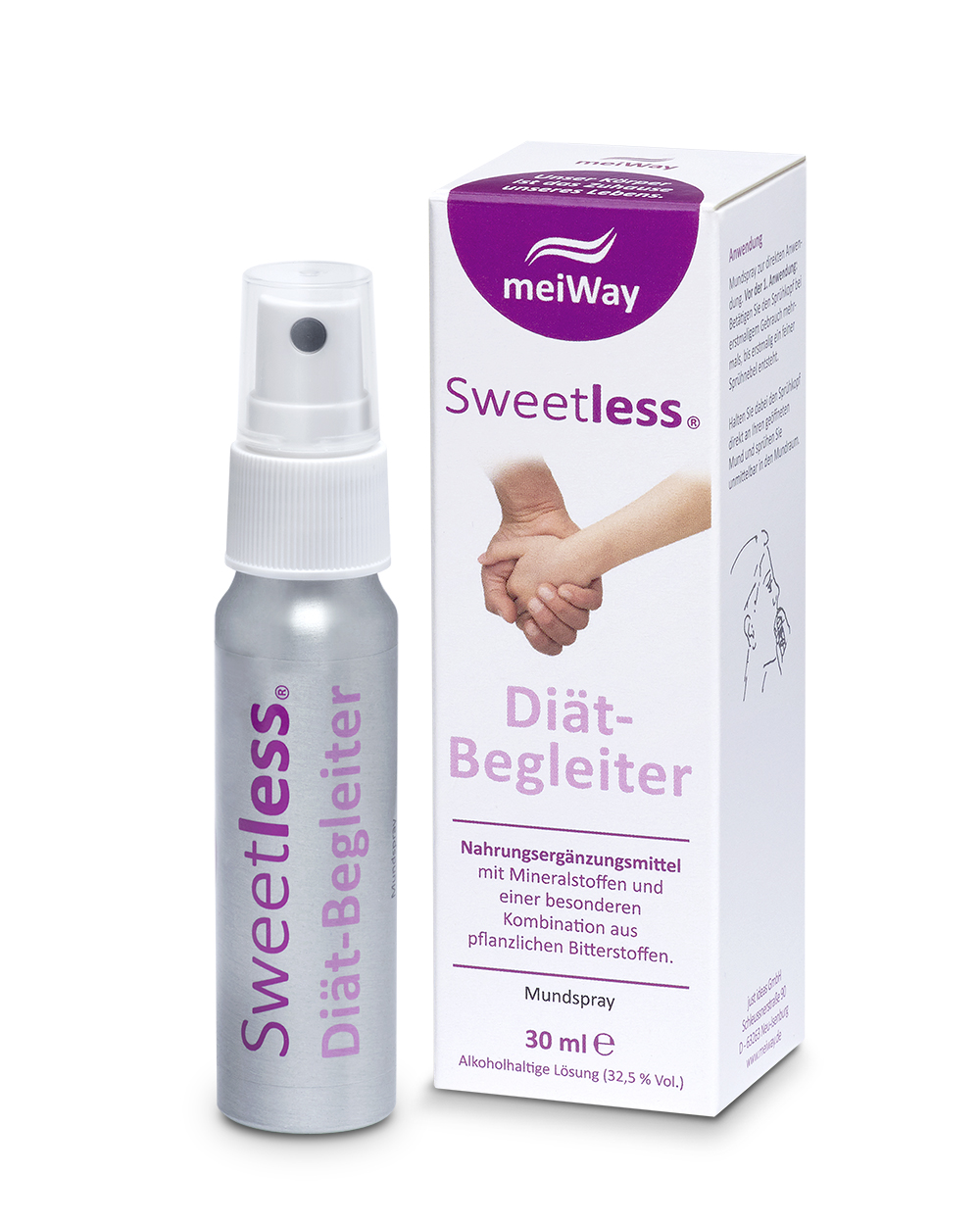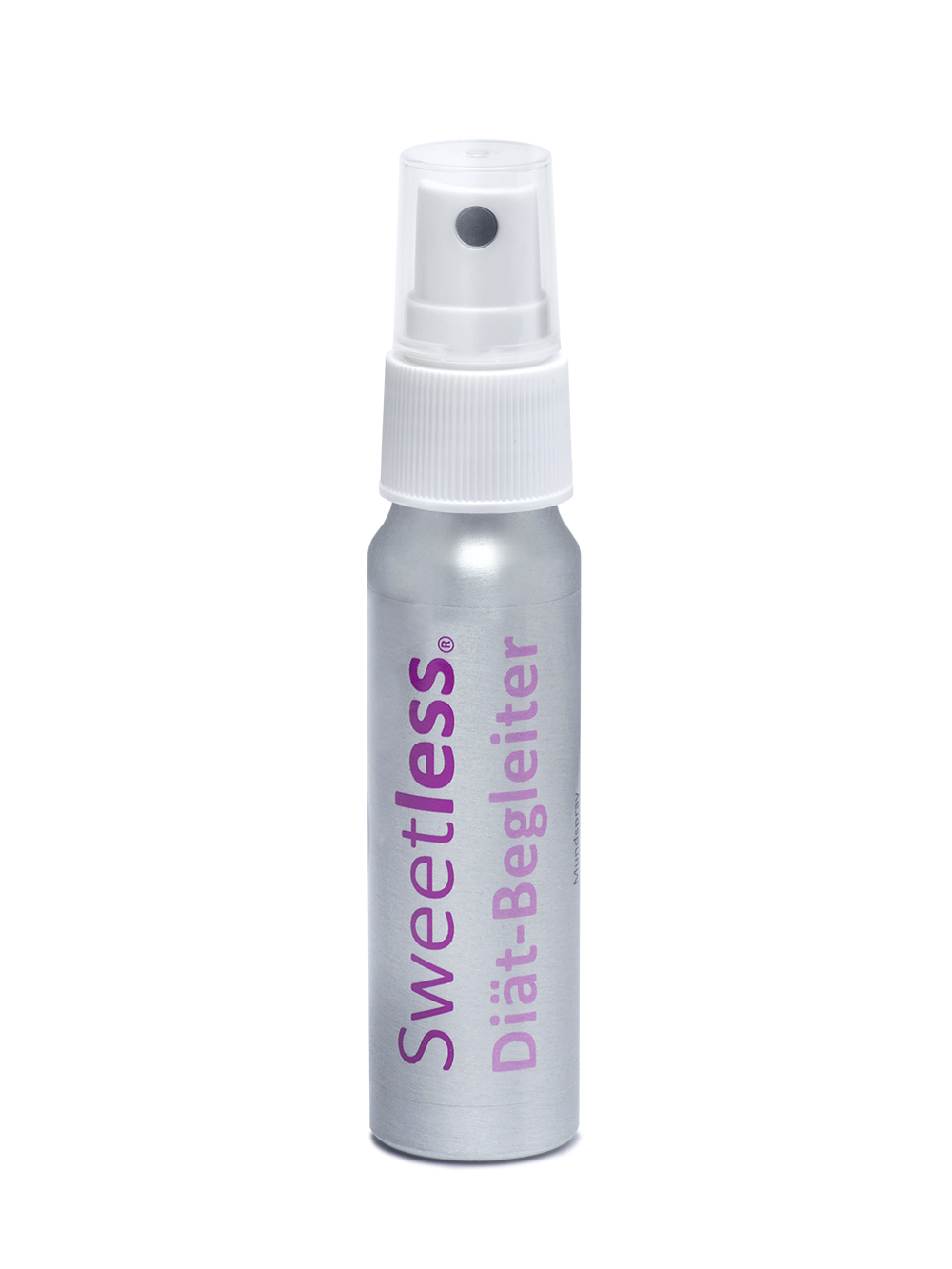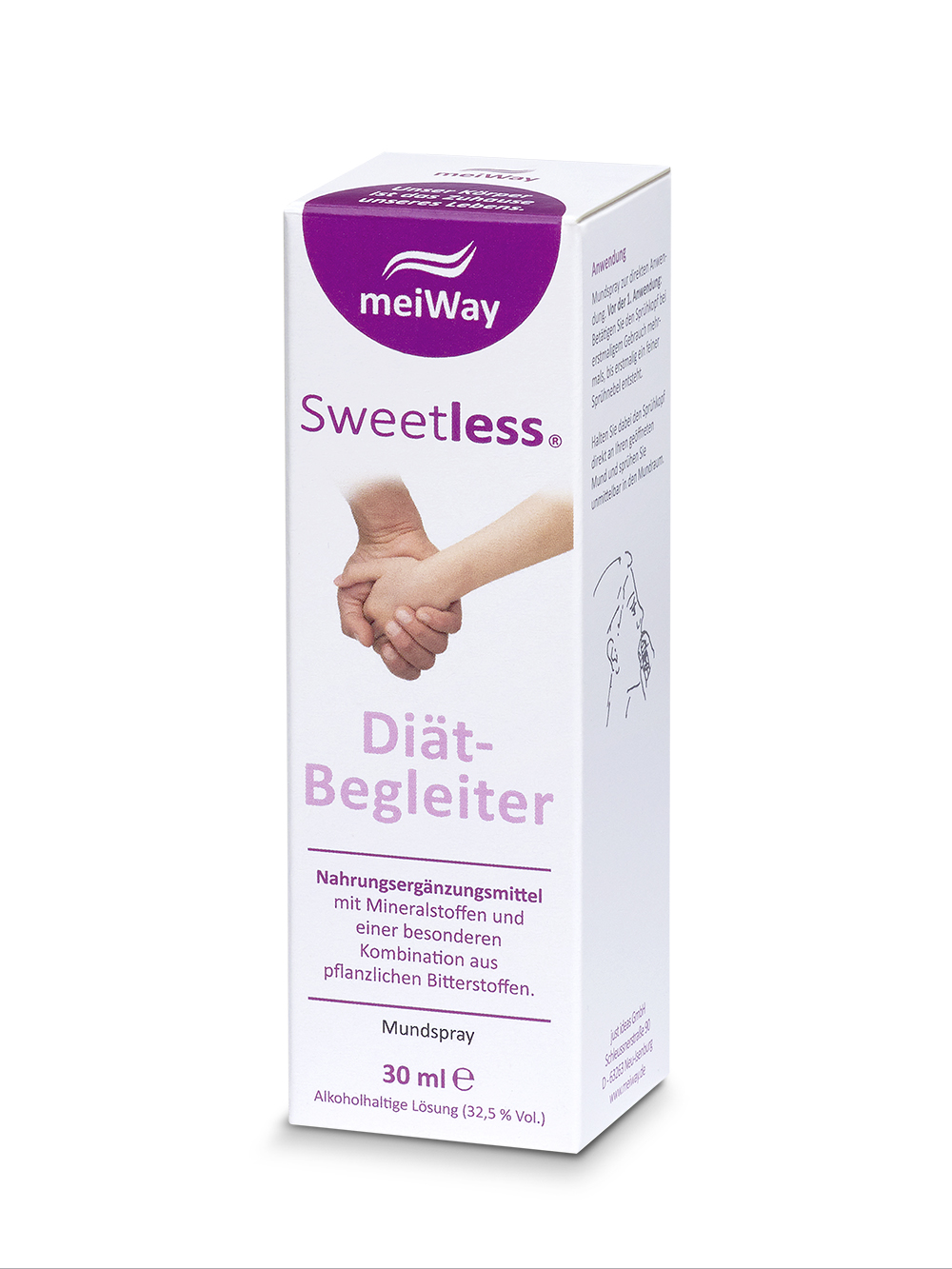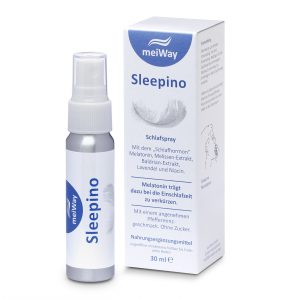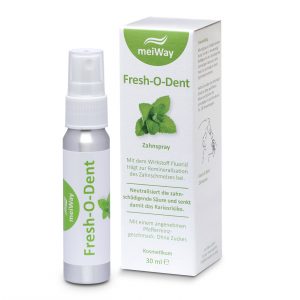Beschreibung
Sweetless® ist ein diätetisches Lebensmittel für besondere medizinische Zwecke, das bei akuten Heißhungerattacken (Binge-Eating-Disorder) angewendet wird.
Es enthält eine besondere Kombination an pflanzlichen Bitterstoffen. Diese unterstützt Sie dabei, ihre Heißhungerattacken erheblich einzuschränken und den Symptomen zielsicher und unmittelbar entgegenzuwirken. Sweetless® unterstützt Sie diätetisch, im Wege eines Ernährungsbeitrages im Sinne des Diätmanagements entgegen zu wirken.
Sweetless® ist ein Mundspray zur direkten Anwendung im Mundraum.
Vor der 1. Anwendung: Betätigen Sie den Sprühkopf bei erstmaligem Gebrauch mehrmals, bis eine feiner Sprühnebel entsteht.
Direkte Anwendung: Halten Sie den Sprühkopf unmittelbar an Ihren geöffneten Mund und sprühen Sie direkt in den Mundraum.
Dosierung und Verzehrempfehlung:
Bei einer sich anbahnenden akuten Heißhungerattacke 1 bis 2x unmittelbar in den Mundraum sprühen. Die Anwendung ist mehrmals täglich möglich. Die tägliche Verzehrmenge von Sweetless® richtet sich nach dem individuellen Bedarf und kann jederzeit und langfristig angewandt werden.
Diese wichtigen Hinweise sollten Sie bei der Einnahme von Sweetless® beachten:
Sweetless® ist eine ergänzende bilanzierte Diät – kein vollständiges Lebensmittel. Die Anwendung ist nur für Erwachsene. Nur unter ärztlicher Aufsicht verwenden. Patienten die unter Bulimie, Magersucht, Alkoholsucht leiden oder schwanger sind, sollten Sweetless nicht anwenden. Nicht in die Augen sprühen.
Nebenwirkungen:
Experimente haben gezeigt, dass die Bestandteile von Sweetless® unbedenklich, uneingeschränkt biokompatibel und sehr gut verträglich sind. Bei der für eine diätetische Behandlung von akuten Heißhungerattacken notwendigen Dosierung wurden keine Nebenwirkungen festgestellt, außer individueller Unverträglichkeit, die zu Übelbefinden führen kann. Wenn die Symptome anhalten, wenden Sie sich bitte direkt an Ihren Arzt.
Zutaten:
Zutaten: Alkohol; Wasser; Kümmelsamenextrakt (30,0%, Extrakt-Verhältnis 1:5); Fenchelsamen-extrakt (30,0 %, Extrakt-Verhältnis 1:5); Korianderfrüchteextrakt (12,5 %, Extrakt-Verhältnis 1:5); Enzianwurzelextrakt (4,0 %, Extrakt-Verhältnis 1:5).
Für 100 ml Sweetless® wurde eine Menge von: 5,5 g Kümmelsamen; 5,5 g Fenchelsamen; 2,3 g Korianderfrüchte; 0,8 g Enzianwurzel verwendet.
| Nährwertdeklaration | pro 100 ml | pro Anwendung | ||
| (2 Sprühstöße) | ||||
| (136 Anwendungen ges.) | ||||
| Brennwert / Energie | 1.425 kj / 369 kcal | 3,14 kj / 0,81 kcal | ||
| Fett | < 0,5 g | 0,0 g | ||
| – davon gesättigte Fettsäuren | 0 g | 0,0 g | ||
| Kohlenhydrate | 1,7 g | 0,0 g | ||
| – davon Zucker | < 0,5 g | 0,0 g | ||
| Eiweiß | < 0,5 g | 0,0 g | ||
| Salz | 0,03 g | 0,0 g |
Packungsgröße:
Inhalt: 30 ml ℮ (für ca. 136 Anwendungen à 2 Sprühstöße)
Lagerung:
Lagern Sie Sweetless® bitte kühl (nicht über 25 °C), trocken, lichtgeschützt und außerhalb der Reichweite von Kindern.
Haltbarkeit:
Das Haltbarkeitsdatum finden Sie auf der Faltschachtel und dem Produktetikett.
Herstellung:
Sweetless® ist eine Forschungs- und studienbasierte Produktentwicklung aus Deutschland und wird selbstverständlich auch in Deutschland, nach strengen Aufsichtskriterien produziert.
Vertrieb und Dialog:
Wenn Sie noch weitere Fragen zu Sweetless® haben, dann wenden Sie sich doch bitte an:
just ideas GmbH – Sweetless®
Schleussnerstrasse 90
D-63263 Neu-Isenburg
Mail: not(ät)justideas.de
Aktueller Stand und letzte Überarbeitung: Februar 2018
5,5g Kümmelsamen;
5,5g Fenchelsamen;
2,3g Korianderfrüchte;
0,8g Enzianwurzel verwendet.
Aus biologischem Anbau In Deutschland und Österreich per Handauslese geerntet.
Diese wichtigen Hinweise sollten Sie bei der Einnahme von Sweetless® bitte beachten:
- Nur unter ärztlicher Aufsicht verwenden.
- Kein vollständiges Lebensmittel – bilanzierte Diät.
- Das Produkt enthält Alkohol. Nicht bei Schwangeren, in der Stillzeit oder bei Kindern und Jugendlichen verwenden.
- Patienten die unter Bulimie, Magersucht oder Alkoholsucht leiden, sollten Sweetless nicht anwenden.
- Nicht in die Augen sprühen.
Mundspray zur direkten Anwendung.
Sweetless® ist ein Mundspray zur diätetischen Behandlung von akuten Heißhungerattacken (Binge-Eating-Disorder).
Sweetless® enthält eine besondere Kombination an pflanzlichen Bitterstoffen. Dies unterstützt Sie diätetisch dabei, Ihre Heißhungerattacken zu reduzieren und den Symptomen im Wege eines Ernährungsbeitrages im Sinne des Diätmanagements entgegen zu wirken.
Die produkteigene Sweetless-Studie hat die aufgeführten Merkmale und Eigenschaften bei Personen, die Sweetless® bei einer sich anbahnenden akuten Heißhungerattacke angewendet haben, nachgewiesen.
Packungsgröße: 30 ml ℮ (für ca. 136 Anwendungen à 2 Sprühstöße)
Sweetless® User Study, Germany 2017
Abstract on Research Paper –
The Sweetless® study, a stratified-randomised, placebo-controlled, double-blind study in 133 participants with binge eating disorder.
Binge Eating Disorder (BED) is an eating dis-order that leads to repeated episodes of binge eating with large amounts of food eaten in a very short time [1]. The American Psychiatric Association recognised BED as an independent form of eating disorder [2]. The prevalence in Germany is 2% [3]. The clinical picture is often associated with overweight [4,5,6,7] and high psychological stress [1,8], whereby the psychological stress caused by loss of control during binge eating episodes is valued higher than the presence of obesity [9]. This results in the therapy recommendation to pay more attention to the feeling of loss of control than to the extent of the binge eating episode or the amount of food consumed [10].
The aim of the present study was to investigate the end and control of binge eating episodes by using a preparation with a strong bitter taste. The tolerability of the study preparation Sweetless was also tested.
Method:
Inclusion and exclusion criteria were specified prior to the recruitment phase. The inclusion criteria were defined according to DSM-5 for the diagnosis of a BED. Exclusion criteria included the use of medication, participation in a weight loss program and behavioral therapy. In February 2017, 136 participants were subsequently recruited on the Internet using the Eating Disorder Examination (16.0D) [11]. Recruitment was limited to people aged between 18 and 64 who lived in Germany. Each participant was informed about the conditions of participation. With the exception of 3 par-ticipants, they all agreed to participate in the study. The 133 participants were stratified by gender and age and randomised into a verum and placebo group. The verum group received a preparation with a strong bitter taste, the placebo group one without taste. Both groups were instructed to use the preparation when noticing the onset of a binge eating episode. The incidence of episodes and other characteristics of eating behavior were recorded through 22 items on a questionnaire before and after the 4-week study phase.
Results:
At the beginning of the study, 59 participants in the verum group (88%) reported ravenous hunger attacks occurring 3 to 4 times per week, per day, or even several times per day. After 4 weeks of treatment, this was still reported by 9 participants (23%). A decrease of 75%.
60 participants (90%) in this group stated that they were able to control acute attacks of ravenous hunger when using the study product and 55 participants (82%) reported that the frequency of acute attacks of ravenous hunger had decreased significantly. 49 participants (73%) felt active and vital-ised after the study. An increase of 68%.
An improvement was observed in 82% of the participants from the verum group and in 9% from the placebo group.
One participant from the verum group reported adverse events. He complained of nausea. Nausea was not accompanied by vomiting and did not result in after-effects.
Conclusion:
In summary, the use of bitter substances in the form of the study product Sweetless can con-tribute to a modern binge eating disorder therapy. The use of bitter constituents provides an option that can end acute attacks of ravenous hunger during binge eating episodes and reduce their occurrence, reduce obesity and improve general psychological well-being.
Literature:
[1] Fairburn CG, Cooper Z,. The Eating Disorder Examination: a semi-structured interview for the assessment of the specific psycho-pathology of eating disorders. International Journal of Eating Disorders.1987; 6: 1-8.
[2] Stetka BS, Correl UC. A Guide to DSM-5 – Binge Eating Disorder. http://www.medscape.com/viewarticle/803884_5, 21 May 2013, accessed: 04 March 2016.
[3] Falkai P, Wittchen HU (Ed.): Diagnostisches und statistisches Manual psychischer Störungen DSM-5. First edition, Hogrefe: Göttingen 2015.
[4] Jacobi F, Höfler M, Strehle J, Mack S, Gersch-ler A, Scholl L, Busch MA, Maske U, Hapke U, Gaebel W, ·Maier W, Wagner M, Zielasek J, Wittchen HU. Psychische Störungen in der All-gemeinbevölkerung. Studie zur Gesundheit Er-wachsener in Deutschland und ihr Zusatzmodul Psychische Gesundheit (DEGS!-MH). Nervenarzt 2014, 85:77-87.
[5] de Zwaan M, Mitchell JE. Binge eating disorder; in Mitchell JE (ed). The Outpatient Treatment of Eating Disorders: A Guide for Therapists, Dieti-tians and Physicians. Minneapolis, University of Minnesota Press, 2001: 59-96.
[6] de Zwaan M. Binge eating disorders (BED) und Adipositas. Review. Verhaltenstherapie 2002;12:288-295.
[7] Agras WS, Telch CF, Arnow B, Eldredge K, Wilfley DE, Raeburn SD, Henderson J, Marnell M. Weight loss, cognitive-behavioral, and desipramine treatments in binge eating disorder: an additive design. Behavior Therapy. 1994;25:209-238
[8] Telch CF, Agras WS. Obesity, binge eating and psychopathology: are they related? International Journal of Eating Disorders. 1994; 15: 53-61.
[9] Beglin SJ, Fairburn CG. The assessment of eating disorder: Interview or self-report ques-tionnaire. International Journal of Eating Disor-der, 1994; 16:363-370.
[10] Telch CF, Pratt EM, Niego SH. Obese women with binge eating disorder define the term binge. International Journal of Eating Disorders. 1998; 24:313-317.
[11]Fairburn CG, Cooper Z, O’Connor. Eating Dis-order Examination (16.0D). Cognitive Behavior Therapy and Eating Disorders. 2008: https://www.researchgate.net/publication/242480332_Eating_Disorder_Examination_160D, ac-cessed: 04 February 2017.
Imprint:
Conduct of the study: ReeHa Lifecare UG (limited liability), Berlin
Author of the study: Frank Reese, Dipl.-Psych.
Medical Writing:
Gerhard Schöpke, Dipl. oec.troph., Master of Science Public Health
Client:
just ideas GmbH, Frankfurt am Main
Correspondence address:
just ideas GmbH, Schleussnerstrasse 90, 86, D-63263 Neu Isenburg.
Conflict of Interest:
The client paid all the costs incurred in carrying out the study. During the analysis of the results, the discussion and conclusion of the study, the author acted independently of the client’s interests and business.
Berlin, 01 June 2017.

